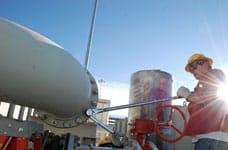What is Turn of Nut Installation?
Turn-of-nut installation is often the preferred method for installing structural bolts for slip-critical joints. There are several options recognized by the Research Council on Structural Connections (RCSC). Here are the basic conditions for bolted, structural joint connections and what you need to know about turn-of-nut-installation.
Bolted Joints
 There are two types of bolted joints: bearing and slip-critical. With bearing joints, the load is transferred between structural members by bearing on the actual bolts. With slip-critical joints, the load is transferred between structural members by friction in the joint. Bolted joints can fail by yielding, where either the bolt or the material it is bearing against bends or deforms. There can also be fractures where the bolt actually breaks or its bearing material breaks or splits.
There are two types of bolted joints: bearing and slip-critical. With bearing joints, the load is transferred between structural members by bearing on the actual bolts. With slip-critical joints, the load is transferred between structural members by friction in the joint. Bolted joints can fail by yielding, where either the bolt or the material it is bearing against bends or deforms. There can also be fractures where the bolt actually breaks or its bearing material breaks or splits.
Slip-Critical Joints
For slip-critical joints, the bolts must be pretensioned. This means the clamping force that holds the members or elements together is greater than the load the joint carries. The frictional resistance between the connected elements keeps the load from slipping onto the bolt; the body of the bolt does not bear the load. Slip-critical joints should be used when holes are oversized or slotted, for joints that are subject to fatigue from reversal of the loading direction and for joints where slipping at the faying surface – where the parts are joined together – would hurt the structural performance.
Bolt Installation
Snug-tight bolt installation is performed with an impact wrench or spud wrench bringing the connected elements into firm contact. Taking the installation further than snug-tight is pretensioning, which, as noted above, is needed for slip-critical installation. Turn-of-nut installation is one method of pretensioning.
Steps for Turn-of-Nut Installation

You can see that turn-of-nut installation is simple and straightforward. The RCSC has a table and additional information on match marking and required turns.
Other Options and Considerations
Calibrated wrench installation is another option for slip-critical joints. A calibration device is used to calibrate the impact wrench to the required torque level. Sample connections are tested to make sure they will achieve the correct tension. You can also use ASTM F1852 installation or ASTM F959 direct tension indicators. F1852 bolts are a twist-off type bolt that must be pretensioned with a twist-off-type tension-control bolt installation wrench. A splined end on the bolt shears off at a specified tension. Direct tension indicators are washers with protrusions that bear against the unturned surface. The protrusions begin to flatten when clamping force is applied. The gap is measured; there is a specified gap size for the pretensioning.
Slip-critical joints are more expensive than snug-tightened, bearing joints, but depending on the design of the structure, they may be necessary. The final decision on bolt installation can be dependent on equipment, experience and installation time. As it does not rely on equipment calibration or special materials, many prefer to use turn-of-the nut installation. The RCSC is an excellent source for additional technical information.
Or, of course, you can contact the experts at Ultra Torq. We’re eager to find the right solution for your industrial needs.
Impact wrench photo credit to VSPYCC under cc 2.0
Biotreatment Area photo credit to PEO ACWA under cc 2.0


